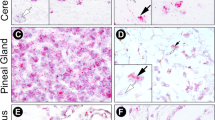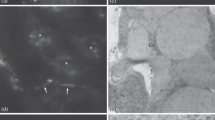Abstract
A number of phenylethylamines and indoleamines have been analyzed in the circumoesophageal ganglia and posterior salivary gland of the normal and pargyline-treated maleOctopus dofleini martini. β-Phenylethylamine,m-tyramine, and tryptamine are present in the optic lobes in amounts of 3, 0.6, and 0.6 ng/g, and in the posterior salivary gland at levels of 1, 64, and 52 ng/g, respectively, in contrast to the much higher levels observed forp-tyramine, octopamine, dopamine, noradrenaline, and 5-hydroxytryptamine. Although pargyline causes a substantial increase in the content of β-phenylethylamine,m-tyramine,p-tyramine, and tryptamine in the optic lobes, no significant changes are observed in the posterior salivary gland. Their relatively rapid metabolism suggests an active role for these amines in the function of nervous tissue in theOctopus.
Similar content being viewed by others
References
Barlow, J.J., Juorio, A.V., andMartin, R. (1974) Monoamine transport in theOctopus posterior salivary gland nerves. J. Comp. Physiol. 89, 105–122.
Blaschko, H., andHawkins, J. (1952) Observation on amine oxidase in cephalopods. J. Physiol. London 118, 88–93.
Bogdanski, D.F., Pletscher, A., Brodie, B.B., andUdenfriend, S. (1956) Identification and assay of serotonin in brain. J. Pharmacol. Exp. Ther. 117, 82–88.
Boulton, A.A., Juorio, A.V., Philips, S.R., andWu P.H. (1975) Some arylalkylamines in rabbit brain. Brain Res. 96, 212–216.
Durden, D.A., Philips, S.R., andBoulton, A.A., (1973) Identification and distribution of β-phenylethylamine in the rat. Can. J. Biochem. 51, 995–1002.
Erspamer V. (1948) Active substances in the posterior salivary glands of octopoda. I. Enteramine-like substance. Acta Pharmacol. Toxicol. 4, 213–223.
Erspamer, V. (1948) Active substances in the posterior salivary glands of octopoda. II. Tyramine and octopamine. Acta Pharmacol. Toxicol. 4, 224–227.
Euler, U.S.V. (1953) Presence of catecholamines in visceral organs of fish and invertebrates. Acta Physiol. Scand. 28, 297–305.
Henze, M. (1913)p-Oxyphenylathylämin, das Speicheldrüsengift der Cephalopoden. Hoppe-Seyler's Z. Physiol. Chem. 87, 51–58.
Juorio, A.V. (1971) Catecholamines and 5-hydroxytryptamine in nervous tissue of cephalopods. J. Physiol. London 216, 213–226.
Juorio, A.V., andKillick, S.W. (1972) Monoamines and their metabolism in molluscs. Comp. Gen. Pharmacol. 3, 283–295.
Juorio, A.V., andKillick, S.W. (1972) The effects of drugs on the synthesis and storage of monoamines in nervous tissues of molluscs. Int. J. Neurosci. 4, 195–202.
Juorio, A.V. andKillick, S.W., (1973) The distribution of monoamines and some of their acid metabolites in the posterior salivary glands and viscera of some cephalopods. Comp. Biochem. Physiol. 44A, 1059–1067.
Juorio, A.V., andMolinoff, P.B. (1974) The normal occurrence of octopamine in neural tissues of theOctopus and other cephalopods. J. Neurochem. 22, 271–280.
Juorio, A.V. andPhilips, S.R. (1975) Tyramines inOctopus nerves. Brain Res. 83, 180–184.
Laverty, R., andSharman, D.F. (1965) The estimation of small quantities of 3,4-dihydroxyphenylethylamine in tissue. Br. J. Pharmacol. 24, 538–548.
Molinoff, P.B., andAxelrod, J. (1969) Octopamine: Normal occurrence in sympathetic nerves of rats. Science 164, 428, 429.
Philips, S.R., Davis, B.A., Durden, D.A., andBoulton, A.A. (1975) Identification and distribution of meta-tyramine in the rat. Can. J. Biochem. 53, 65–69.
Philips, S.R., Durden, D.A., andBoulton, A.A. (1974) Identification and distribution ofp-tyramine in the rat. Can. J. Biochem. 52, 366–373.
Philips, S.R., Durden, D.A., andBoulton, A.A. (1974) Identification and distribution of tryptamine in the rat. Can. J. Biochem. 52, 447–451.
Robertson, H.A., andJuorio, A.V. (1977) Octopamine and some related noncatecholic amines in invertebrate nervous systems. Int. Rev. Neurobiol. 19, 173–224.
Saavedra, J.M. (1974) Enzymatic isotopic method for octopamine at the picogram level. Anal. Biochem. 59, 628–633.
Usdin, E., andSandler, M. (eds.) (1976) Trace Amines and the Brain, M. Dekker, New York.
Author information
Authors and Affiliations
Rights and permissions
About this article
Cite this article
Juorio, A.V., Philips, S.R. Arylalkylamines inOctopus tissues. Neurochem Res 1, 501–509 (1976). https://doi.org/10.1007/BF00964211
Accepted:
Issue Date:
DOI: https://doi.org/10.1007/BF00964211




